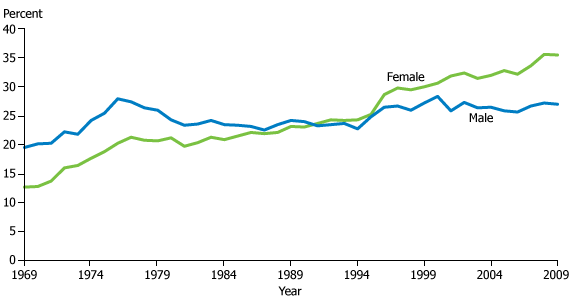Kelvin Pollard
Former Senior Demographer

By almost any measure, Americans have become more educated over the last 40 years. They are more likely to graduate from high school, enroll in college, and obtain degrees today than they were in 1970. According to the U.S. Census Bureau’s 2009 Current Population Survey, more than half of Americans ages 25 and older have continued their formal education beyond high school, compared with just one-fifth in 1970. The share attaining at least a bachelor’s degree has risen from 11 percent to 30 percent over that same period. And young adults are even more educated—one in three has at least a bachelor’s degree. This phenomenon has occurred among men and women, and in each major racial and ethnic group, although education levels are much lower among Latinos and blacks.
A deeper look at these statistics, however, reveals another phenomenon—the “feminization” of higher education. Simply put, young women are now more likely to enroll in, and graduate from, college than young men. Where historically men have been more likely to finish college, since 1991 the share of women ages 25 to 29 with a bachelor’s degree or higher has exceeded the share of young men with the same credentials (see figure). And the gap has widened in recent years due to stagnation in the rate of young men earning degrees. Moreover, this phenomenon is present among all major race and ethnic groups. Women not only represent a majority of young adults enrolled as college undergraduates, but they also are now nearly three-fifths of graduate students.
Percent of U.S. Adults Ages 25-29 With a Bachelor’s Degree or Higher, 1969-2009

Source: PRB analysis of data from U.S. Census Bureau.
This gender difference is present in other ways. For example, a study by the NCAA (the major governing body for intercollegiate athletics) on Division I institutions showed that, for the entering class of 2003, 90 percent of white female student-athletes (students receiving some form of athletics-based assistance) and 76 percent of African American female student-athletes graduated from their institutions within six years. The comparative rates for male student-athletes were 78 percent for whites and 59 percent for blacks.1 On a similar note, the University of Central Florida’s Institute for Diversity and Ethics in Sport reported that 23 of 63 reporting colleges whose teams qualified for the 2011 NCAA women’s basketball tournament graduated all of their players from the freshman classes of 2000 through 2003 within a six-year period, compared to seven of 67 reporting schools that qualified for the men’s tournament. Moreover, 57 women’s teams graduated at least 70 percent of their players, compared with 32 men’s teams.2
